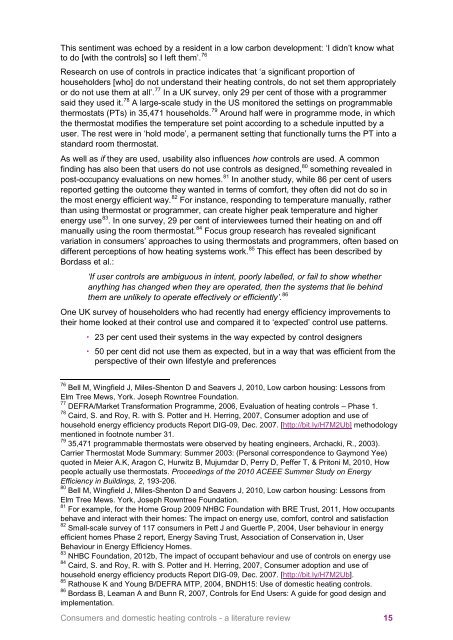Consumers-and-domestic-heating-controls-a-literature-review
Consumers-and-domestic-heating-controls-a-literature-review
Consumers-and-domestic-heating-controls-a-literature-review
Create successful ePaper yourself
Turn your PDF publications into a flip-book with our unique Google optimized e-Paper software.
This sentiment was echoed by a resident in a low carbon development: ‘I didn’t know what<br />
to do [with the <strong>controls</strong>] so I left them’. 76<br />
Research on use of <strong>controls</strong> in practice indicates that ‘a significant proportion of<br />
householders [who] do not underst<strong>and</strong> their <strong>heating</strong> <strong>controls</strong>, do not set them appropriately<br />
77<br />
or do not use them at all’. In a UK survey, only 29 per cent of those with a programmer<br />
said they used it. 78 A large-scale study in the US monitored the settings on programmable<br />
thermostats (PTs) in 35,471 households. 79<br />
Around half were in programme mode, in which<br />
the thermostat modifies the temperature set point according to a schedule inputted by a<br />
user. The rest were in ‘hold mode’, a permanent setting that functionally turns the PT into a<br />
st<strong>and</strong>ard room thermostat.<br />
As well as if they are used, usability also influences how <strong>controls</strong> are used. A common<br />
80<br />
finding has also been that users do not use <strong>controls</strong> as designed, something revealed in<br />
post-occupancy evaluations on new homes. 81 In another study, while 86 per cent of users<br />
reported getting the outcome they wanted in terms of comfort, they often did not do so in<br />
the most energy efficient way. 82 For instance, responding to temperature manually, rather<br />
than using thermostat or programmer, can create higher peak temperature <strong>and</strong> higher<br />
energy use 83 . In one survey, 29 per cent of interviewees turned their <strong>heating</strong> on <strong>and</strong> off<br />
manually using the room thermostat. 84 Focus group research has revealed significant<br />
variation in consumers’ approaches to using thermostats <strong>and</strong> programmers, often based on<br />
different perceptions of how <strong>heating</strong> systems work. 85<br />
This effect has been described by<br />
Bordass et al.:<br />
‘If user <strong>controls</strong> are ambiguous in intent, poorly labelled, or fail to show whether<br />
anything has changed when they are operated, then the systems that lie behind<br />
86<br />
them are unlikely to operate effectively or efficiently’.<br />
One UK survey of householders who had recently had energy efficiency improvements to<br />
their home looked at their control use <strong>and</strong> compared it to ‘expected’ control use patterns.<br />
� 23 per cent used their systems in the way expected by control designers<br />
� 50 per cent did not use them as expected, but in a way that was efficient from the<br />
perspective of their own lifestyle <strong>and</strong> preferences<br />
76<br />
Bell M, Wingfield J, Miles-Shenton D <strong>and</strong> Seavers J, 2010, Low carbon housing: Lessons from<br />
Elm Tree Mews, York. Joseph Rowntree Foundation.<br />
77<br />
DEFRA/Market Transformation Programme, 2006, Evaluation of <strong>heating</strong> <strong>controls</strong> – Phase 1.<br />
78<br />
Caird, S. <strong>and</strong> Roy, R. with S. Potter <strong>and</strong> H. Herring, 2007, Consumer adoption <strong>and</strong> use of<br />
household energy efficiency products Report DIG-09, Dec. 2007. [http://bit.ly/H7M2Ub] methodology<br />
mentioned in footnote number 31.<br />
79<br />
35,471 programmable thermostats were observed by <strong>heating</strong> engineers, Archacki, R., 2003).<br />
Carrier Thermostat Mode Summary: Summer 2003: (Personal correspondence to Gaymond Yee)<br />
quoted in Meier A.K, Aragon C, Hurwitz B, Mujumdar D, Perry D, Peffer T, & Pritoni M, 2010, How<br />
people actually use thermostats. Proceedings of the 2010 ACEEE Summer Study on Energy<br />
Efficiency in Buildings, 2, 193-206.<br />
80<br />
Bell M, Wingfield J, Miles-Shenton D <strong>and</strong> Seavers J, 2010, Low carbon housing: Lessons from<br />
Elm Tree Mews. York, Joseph Rowntree Foundation.<br />
81<br />
For example, for the Home Group 2009 NHBC Foundation with BRE Trust, 2011, How occupants<br />
behave <strong>and</strong> interact with their homes: The impact on energy use, comfort, control <strong>and</strong> satisfaction<br />
82<br />
Small-scale survey of 117 consumers in Pett J <strong>and</strong> Guertle P, 2004, User behaviour in energy<br />
efficient homes Phase 2 report, Energy Saving Trust, Association of Conservation in, User<br />
Behaviour in Energy Efficiency Homes.<br />
83<br />
NHBC Foundation, 2012b, The impact of occupant behaviour <strong>and</strong> use of <strong>controls</strong> on energy use<br />
84<br />
Caird, S. <strong>and</strong> Roy, R. with S. Potter <strong>and</strong> H. Herring, 2007, Consumer adoption <strong>and</strong> use of<br />
household energy efficiency products Report DIG-09, Dec. 2007. [http://bit.ly/H7M2Ub].<br />
85<br />
Rathouse K <strong>and</strong> Young B/DEFRA MTP, 2004, BNDH15: Use of <strong>domestic</strong> <strong>heating</strong> <strong>controls</strong>.<br />
86<br />
Bordass B, Leaman A <strong>and</strong> Bunn R, 2007, Controls for End Users: A guide for good design <strong>and</strong><br />
implementation.<br />
<strong>Consumers</strong> <strong>and</strong> <strong>domestic</strong> <strong>heating</strong> <strong>controls</strong> - a <strong>literature</strong> <strong>review</strong> 15


